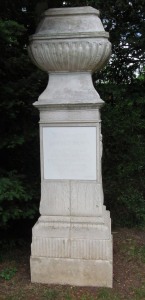a well made torso contains all of life – one doesn’t add anything by joining legs and arms to it Auguste Rodin 1908
The Brown Advisor speculates here that more than just a head of Brown could emerge for the Tercentenary. This will be rather exciting, seeing the diverse outputs of a number of artistic processes with a common subject. But it is worth considering the difference between statues, busts and heads.
Figurative statues cost a lot of money – at least £50,000 for a single, full length figure at a human scale. Subscriptions usually fund statues, at local, national or governmental level. In Britain, public art is sometimes financed through contributions from commercial developers for the benefit of the communities which their developments serve. Works outside must be capable of withstanding vandalism and weather. A plinth is needed between the work and the substrate for reasons of security and fixing; traditionally plinths elevated the work above the viewer to confer more importance and perhaps to enable it to be seen more easily over the heads of a crowd. Their height needs to cope with viewing from those who are standing or walking. Rodin’s masterpiece Burghers of Calais (above) has traditionally been plinthed high though the artist actually wanted it at ground level so the figures could have a human scale interaction with the viewer, meeting at or near eye level so that expression can be sensed.
 If a statue becomes over-descriptive, it loses artistic qualities and becomes merely interpretative. We can tell Barbara Jordan’s physical characteristics
If a statue becomes over-descriptive, it loses artistic qualities and becomes merely interpretative. We can tell Barbara Jordan’s physical characteristics
from this Texas statue (right), but does it contribute as an artform as well as a memorial to her? What we must ascertain is whether the sources which influence the creation of the work are actually personal enough to contribute to a truthful work – or whether it just provides something more bland and general. Much public sculpture is not art.
 The bust has classical roots, and often conveyed the head and shoulders – or the upper body – on a raised socle, which gave the sculpture ‘lift’ both physically and visually. The addition of the shoulder and/or upper torso in the bust form adds mass to the head to enable it it cope better with public display (perhaps on a column), as well as giving further information as to the stature of the sitter. The portrait head is often confusingly and erroneously referred to as a bust just because the term ‘bust’ links it more firmly to sculpture rather than painting.
The bust has classical roots, and often conveyed the head and shoulders – or the upper body – on a raised socle, which gave the sculpture ‘lift’ both physically and visually. The addition of the shoulder and/or upper torso in the bust form adds mass to the head to enable it it cope better with public display (perhaps on a column), as well as giving further information as to the stature of the sitter. The portrait head is often confusingly and erroneously referred to as a bust just because the term ‘bust’ links it more firmly to sculpture rather than painting.
Two simple sculptural building blocks, the ovoid and cylinder, equate to the head and neck and arguably give us everything we could possibly ask for in conveying the feel of the individual, if we can get both the relative proportions of each form correct and the relative balance to each other. Think of Henry Moore. His monumental works sit across the globe. His own physical presence? Marked by a tiny – smaller than lifesize – portrait head modelled directly from Moore by Marino Marini in 1962, now in the National Portrait Gallery collection. It has immense power.

 I don’t think Moore would have appreciated a full-length statue. One might ask the same of Brown, someone who appreciated the rigorous visual experience. It is interesting that 18th Century memorials erected to him by long-standing, appreciative clients at Wrest (left) and at Croome (right) are both in form of an urn on column.
I don’t think Moore would have appreciated a full-length statue. One might ask the same of Brown, someone who appreciated the rigorous visual experience. It is interesting that 18th Century memorials erected to him by long-standing, appreciative clients at Wrest (left) and at Croome (right) are both in form of an urn on column.
A more detailed post on the posthumous Balzac memorial by Rodin can be seen here.


